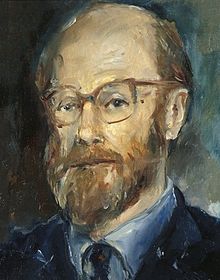Patrick David Wall
Patrick David Wall , also Pat Wall, (born April 25, 1925 in Nottingham , † August 8, 2001 ) was a British physician, neurobiologist and pain researcher .
Wall, whose father was educational director for Middlesex, attended St. Paul's School in London and studied medicine at Oxford University ( Christ Church College ) and at Middlesex Hospital in London. As a student, he turned to neuroscience. By the time he graduated in 1948 he had already published three scientific papers. He then was an instructor at the Yale School of Medicine . 1950 to 1953 he was at the University of Chicago , where he was Assistant Professor , 1953 to 1955 at Harvard University and from 1957 Associate Professor and 1960 Professor at the Massachusetts Institute of Technology . In 1967 he returned to Great Britain as Professor of Anatomy at University College London (in the department of John Zachary Young ). In 1990 he retired and continued his research at St. Thomas Hospital.
From 1973 he was also at the Hebrew University in Jerusalem (with his own laboratory).
Wall developed the gate control theory of pain with Ronald Melzack . It was a synthesis of the previously opposed intensity theory and specificity theory of pain and led to an upheaval in pain theory. The theory arose from the paradoxical observation that the intensity of pain often does not correlate with the extent of injury. An essential stimulus came from a book by the surgeon Willem Noordenbos , which investigated the question of why the severing of nerve fibers in chronic pain patients often leads to opposite results after a while instead of the hoped-for pain suppression. The first publication on this in 1962 received hardly any attention and the second in Science 1965 mostly negative reception. Only with the new therapeutic options based on it, for which Wall and William H. Sweet made a pioneering contribution in 1967, did the theory gain broader recognition. It was created mainly by Norman Shealy the Transcutaneous Electrical Nerve Stimulation (TENS), first in the 1970s as a screening tool for DCS, and the Dorsal Column Stimulation (called DCS, later Spinal Column Stimulation, SCS, spinal cord stimulation ). Wall wrote two popular science books on pain.
Inspired by injuries from the Yom Kippur war (which he examined together with the surgeon Willem Noordenbos), he turned to research into phantom pain and pain as a result of nerve damage. He attributed chronic pain to changes in the central nervous system, which was initially received very critically.
He was a member of the American Academy of Arts and Sciences (1961), Fellow of the Royal Society of Physicians (1984), the Royal Society of Anaesthesiologists (1992) and the Royal Society (1989). In 1988 he received the Sherrington Medal of the Royal Society of Medicine and in 1999 the Royal Medal . In 1993 he became a lifelong member of the International Association for the Study of Pain .
He was the editor and founder of Pain magazine . He wrote around 400 scientific publications, the first at the age of 21 (published in the journals Brain and Nature ).
He was politically left-wing and anti-authoritarian, was politically active, for example, against apartheid and in Oxford Chairman of the Socialist Club and founder of the British Medical Students Journal , in which he advocated the establishment of the National Health Service .
In 1996 he was diagnosed with prostate cancer. Wall was married three times (two marriages ended in divorce). One of his hobbies was bird watching.
Fonts
- with R. Melzack: The Challenge of Pain , Penguin 1982, 2nd edition 1989
- Pain. The Science of Suffering , Columbia University Press 2002
- with R. Melzack (editor): The Textbook of Pain , Churchill Livingstone 1983, 4th edition 1999
- New edition Stephen B. MacMahon, Martin Koltzenburg (Eds.), Wall and Melzack's Textbook of Pain , Churchill-Livingstone, 5th edition 2006
He also wrote a thriller.
Web links
Individual evidence
- ^ R. Melzack, PD Wall: Pain mechanisms: a new theory , Science, Volume 150, 1965, pp. 971-979
- ↑ PD Wall, WH Sweet, Temporary abolition of pain in man , Science, Volume 155, 1967, pp. 108-109
- ↑ CN Shealy, JT Mortimer, JB Reswick, Electrical inhibition of pain by stimulation of the dorsal columns: preliminary clinical report , in: Anesthesia and Analgesia , Volume 46, 1967, pp. 489-491
- ↑ Book of Members 1780 – present, Chapter W. (PDF; 852 kB) In: American Academy of Arts and Sciences (amacad.org). Retrieved May 24, 2019 .
- ^ TRIO - The Revolting Intellectuals' Organization , 1966
| personal data | |
|---|---|
| SURNAME | Wall, Patrick David |
| ALTERNATIVE NAMES | Wall, Pat |
| BRIEF DESCRIPTION | British neurobiologist |
| DATE OF BIRTH | April 25, 1925 |
| PLACE OF BIRTH | Nottingham |
| DATE OF DEATH | August 8, 2001 |
